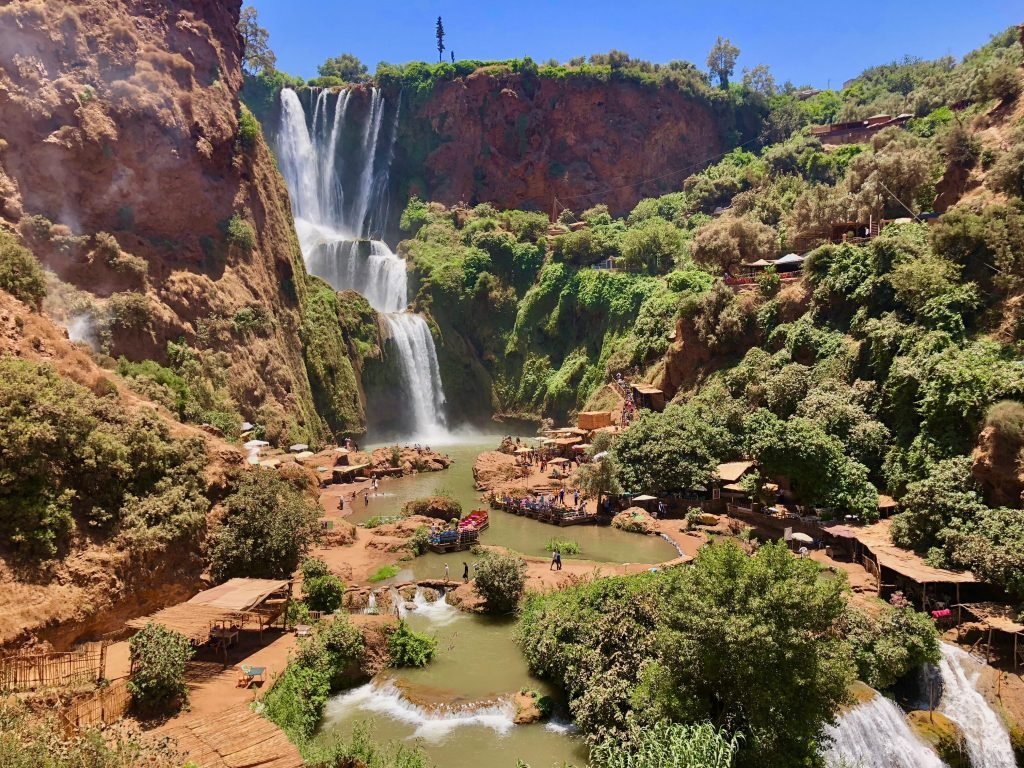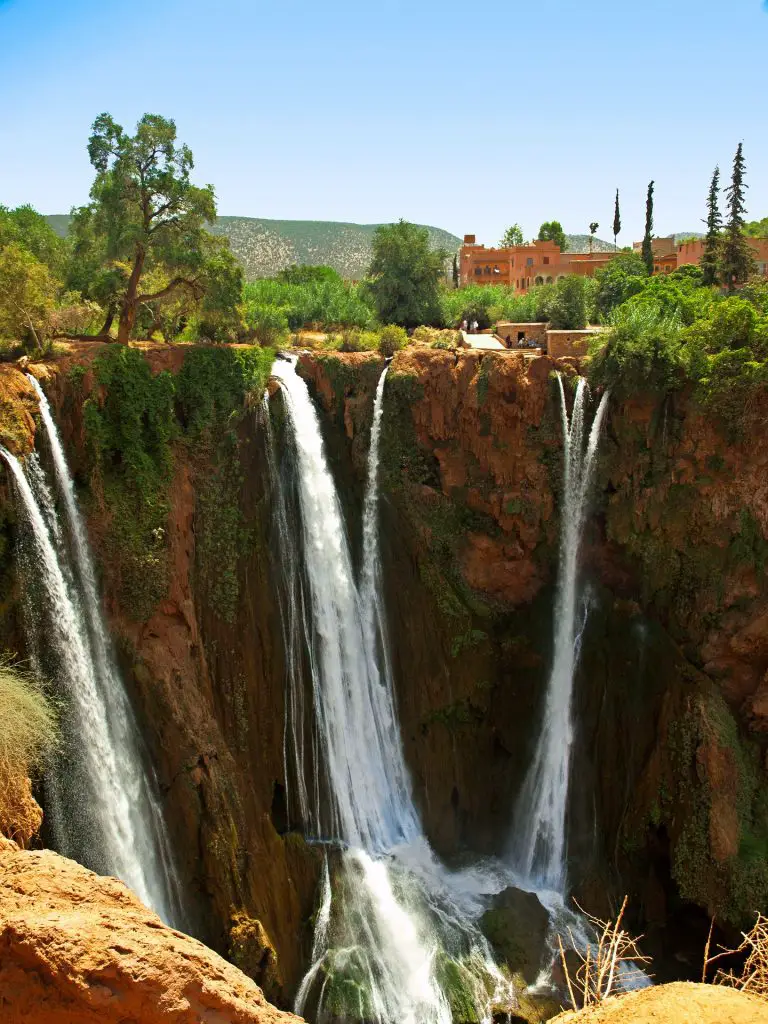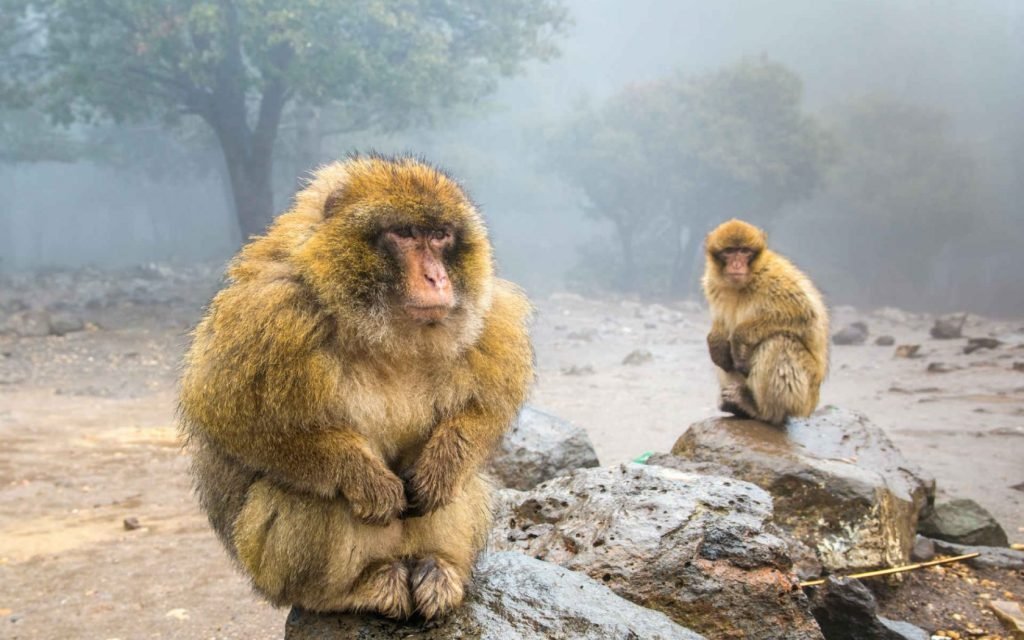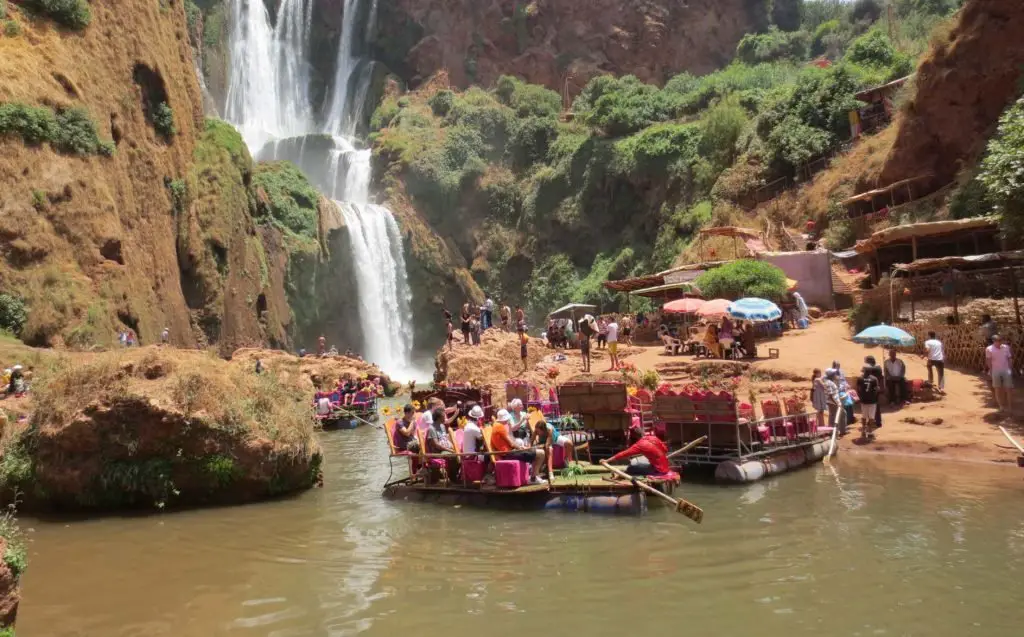Hidden within Morocco’s Atlas Mountains, Ouzoud Falls presents a breathtaking natural spectacle. Seven cascading waterfalls create a mesmerizing symphony of rushing water and rainbow-filled mist. Deriving its name from the Berber word for “olive,” Ouzoud Falls stands as one of North Africa’s most impressive waterfalls, dramatically descending through a series of terraced drops totaling 110 meters in height.
For centuries, these falls have been more than just a scenic wonder, serving as a vital cultural cornerstone for local Berber communities, powering traditional mills, and acting as a significant gathering place for trade and storytelling. Today, this natural marvel continues to enchant visitors while deeply rooted in its cultural significance.

Location and Accessibility: Getting to Ouzoud Falls from Marrakech
Ouzoud Falls is situated 150 kilometers northeast of Marrakech, Morocco, near the charming village of Tanaghmeilt. The journey from Marrakech typically takes around two and a half hours due to winding mountain roads with limited signage.
Transportation Options to Ouzoud Falls
Visitors have several convenient ways to reach the waterfalls:
- Organized Day Tours from Marrakech: Many tourists opt for hassle-free organized day tours, which usually allocate 3-4 hours at the site. These tours manage the challenging navigation through the mountain roads, offering a practical and comfortable option.
- Rental Cars: For independent travelers, renting a car provides flexibility. However, driving requires confidence on Morocco’s mountain roads. Ensure you have a reliable GPS and offline maps as signage can be limited.
- Air-Conditioned Taxis: Hiring a private taxi offers a comfortable option, especially appreciated during the hot summer months. Agree on the fare beforehand.
Planning Your Trip from Marrakech
Most day trips from Marrakech to Ouzoud Falls commence early in the morning, with return journeys scheduled for the evening. Hotels in Marrakech often assist guests in arranging transportation or connecting them with reputable tour operators. While the distance might seem short on a map, the actual travel time reflects the road conditions and mountainous terrain. The scenic route passes through small villages and beautiful landscapes, adding to the journey’s appeal.
Etymology and Unique Physical Characteristics of Ouzoud Falls
Ouzoud Falls is a striking natural wonder in Morocco, characterized by seven distinct cascades that gracefully tumble through a picturesque gorge. The main waterfall is conveniently located near Tanaghmeilt village, offering visitors an awe-inspiring view of this natural formation.

The Circular Cascade System
The waterfall system follows a unique circular pattern, with each cascade contributing to the overall impressive flow. Numerous paths meander around the falls, providing visitors with diverse perspectives and vantage points at varying heights. The falls are part of a larger natural environment where the water has sculpted the landscape, creating deep pools and dramatic rocky outcrops.
Terraced Tiers and Natural Amphitheater
The structure of Ouzoud Falls includes several tiers, each enhancing the site’s visual splendor. Water powerfully rushes down through these levels before reaching the base, where it gathers in inviting pools surrounded by lush local vegetation. The pathways naturally follow the contours of the gorge, granting access to stunning viewing spots at different elevations. The physical layout of Ouzoud Falls creates a natural amphitheater effect, with the resounding sound of the cascading water echoing off the gorge walls. The surrounding area, adorned with rocky outcrops and native plants, further emphasizes the falls as a focal point of natural beauty in the region.
Cultural Significance and Historical Context of Ouzoud Falls
The name “Ouzoud” originates from the Berber word for “olive,” a testament to the numerous olive groves that blanket the surrounding hills. For generations, the falls have been a vital gathering place for local Berber communities, serving as both a social center and a crucial water source.
A Historical Meeting Point
Throughout history, Ouzoud Falls acted as a significant meeting point where different Berber tribes would converge to trade goods, exchange news, and strengthen social bonds. The cascading waters formed a natural boundary between tribal territories while simultaneously uniting people at this shared natural resource.
Traditional Berber Mills
Local Berber families have historically maintained small mills near the falls, harnessing the water’s power to grind grain into flour. These traditional mills stand as enduring symbols of how communities have sustainably interacted with the natural landscape to support their livelihoods.
Spiritual Significance in Local Folklore
Ouzoud Falls holds deep spiritual significance in local Berber folklore. Tradition holds that the frequent rainbows appearing in the falls’ mist represent a sacred bridge connecting the physical and spiritual realms. Many older residents recount tales of ancestral spirits residing in the hidden caves behind the cascading water.
Preserving Tradition Amidst Tourism
Today, while tourism brings increased attention to Ouzoud Falls, local Berber communities continue their traditional practices around the site, preserving their historical and cultural connection to this remarkable natural formation.
Wildlife Encounters and Natural Attractions at Ouzoud Falls
A significant attraction at Ouzoud Falls is its thriving population of Barbary macaques, which freely roam the area. These native monkeys of Morocco’s Atlas Mountains are frequently seen near the waterfalls, especially during the cooler morning and late afternoon hours. While generally social and accustomed to visitors, it’s crucial to remember they are wild animals in their natural habitat.

Diverse Ecosystem and Birdlife
The ecosystem surrounding the falls supports a variety of local wildlife beyond the macaques. Colorful birds like kingfishers and graceful wagtails nest near the cascades, while majestic eagles occasionally soar overhead. The mist generated by the falls creates ideal conditions for diverse plant species, including wild olive trees and vibrant seasonal wildflowers.
Responsible Wildlife Viewing
When visiting the falls, it’s essential to maintain a respectful distance from the Barbary macaques. While they may approach visitors, feeding them disrupts their natural behaviors and can be harmful. Photography is encouraged, but please refrain from using flash, which can startle the animals. Local guides often know the best spots to observe the monkeys without disturbing them.
Seasonal Changes in Flora and Fauna
The area’s plant life transforms with the seasons. Spring brings a burst of colorful blooms, while autumn sees the olive trees laden with fruit. Small caves and unique rock formations around the falls provide shelter for various small mammals and birds, contributing to the site’s rich biodiversity. The harmonious blend of water, vegetation, and wildlife makes Ouzoud Falls a captivating destination for nature enthusiasts.
Activities and Recreational Opportunities at Ouzoud Falls
A scenic circular walking path encircles Ouzoud Falls, typically taking around 3 hours to complete at a leisurely pace. The trails offer varying levels of difficulty, ranging from gentle paths at the top to steeper sections leading down to the gorge. It’s important to exercise caution as some rocky areas can become slippery, especially during wet weather.
Swimming and Boating at the Falls
Inviting swimming spots can be found at the base of the falls, although visitors should be aware that currents can sometimes be strong. Local signage usually indicates safe swimming areas, and it’s advisable to check water conditions before entering. Summer attracts more swimmers seeking relief from the heat, while winter sees fewer people due to cooler temperatures. Small boats offer unique rides at the base of the falls, providing an up-close and often wet experience of the powerful cascades. These boat rides typically cost around 20 MAD per person.

Photography Opportunities
Ouzoud Falls presents countless stunning photographic opportunities. The most dramatic shots can often be captured from the base, where the full grandeur of the cascades is framed against the sky. Morning light frequently creates beautiful rainbows in the mist, making it an ideal time for photography. The circular route offers diverse angles to photograph the falls, with strategically placed viewing platforms along the way.
Hiking Trails and Rest Stops
Small restaurants and convenient rest stops are dotted along the trails, offering opportunities to take breaks and enjoy refreshments. The paths feature handrails in steeper sections, enhancing accessibility for most visitors. Local guides can often point out hidden viewpoints and tranquil spots away from the more crowded areas, although self-guided walks are easily manageable using the well-marked paths.
Cultural Experiences and Local Cuisine Around Ouzoud Falls
The area surrounding Ouzoud Falls provides authentic opportunities to interact with Berber communities. Local families operate charming small shops and cafes along the paths, selling traditional handicrafts and regional culinary specialties. When visiting these establishments, a polite greeting of “Salam” is customary, and taking a moment for friendly conversation is appreciated.
Traditional Moroccan Dishes
Traditional Moroccan dishes are prominently featured at the riverside restaurants. Many eateries serve delicious tagine, a slow-cooked stew prepared with local vegetables and meats. Freshly baked bread, fragrant mint tea, and locally produced olive oil often accompany these meals. Small cafes offer quick and tasty snacks such as dates, nuts, and freshly squeezed orange juice.
Engaging with Local Guides and Traditions
Knowledgeable local guides share fascinating stories about the historical and cultural significance of the area while leading visitors along less-traveled paths. These tours often include insightful stops at traditional olive oil mills, where families demonstrate centuries-old pressing techniques. Visitors are advised to dress modestly and always seek permission before photographing local residents.
Social Spaces and Local Treats
Several viewing platforms near the falls also serve as social gathering spots for Berber families. Here, visitors might be fortunate enough to witness impromptu music performances featuring traditional instruments. Small food stands run by local women offer delectable homemade pastries and Moroccan cookies, providing a genuine taste of local home cooking.
Exploring Olive Groves
The paths leading to Ouzoud Falls meander through picturesque olive groves where farmers still employ traditional harvesting methods. During the olive season, visitors may have the opportunity to observe – and sometimes even participate in – the picking process, gaining firsthand knowledge of this important aspect of local life.
Essential Travel Tips for Visiting Ouzoud Falls
The optimal time to visit Ouzoud Falls depends on your preferences. Spring (March-May) offers mild temperatures and moderate water flow, ideal for hiking and photography. Autumn (September-November) provides similar pleasant conditions with fewer crowds. Summer attracts more visitors seeking to swim in the warmer waters, while winter sees the lowest visitor numbers and higher water levels.
Best Times for Photography and Avoiding Crowds
Morning visits generally offer the best lighting conditions for photography, with sunlight often creating stunning rainbows in the mist. Afternoon crowds tend to peak between 2 PM and 4 PM, so arriving early can help you avoid the busiest times. The falls are open year-round, and there is no entrance fee, although hiring local guides is an optional expense.
Understanding Weather and Accessibility
Weather patterns significantly influence the falls’ appearance and accessibility. Rainfall can make paths slippery, requiring extra caution on stone steps. During the summer heat, it’s crucial to bring ample water, sun hats, and sunscreen. Winter visitors should pack warm layers as temperatures can drop considerably in the gorge.
Responsible Tourism and Conservation
Visitors play a vital role in preserving the beauty of Ouzoud Falls. Please stay on marked paths to prevent erosion, ensure you carry out all your trash, and avoid feeding the local wildlife, particularly the Barbary macaques. Numerous small bins are located along the trails, and local conservation groups actively work to maintain the site’s natural beauty.
Facilities and Practical Advice
The area provides basic facilities, including restrooms, parking lots, and small shops. Comfortable walking shoes are essential for navigating the rocky terrain, and carrying cash is advisable for purchasing from local vendors or hiring guides.
Visitor Precautions and Recommended Gear for Ouzoud Falls
The paths at Ouzoud Falls vary from well-maintained steps near the parking area to more natural earthen trails around the cascades. The main path from the car park features sturdy railings and wide steps, making it suitable for most visitors. However, certain sections can become slippery after rain, so careful footing is necessary.
Essential Gear Checklist
For a safe and enjoyable visit, it’s recommended to bring the following:
- Sturdy hiking shoes with good grip
- Sun hat and sunscreen, especially during summer
- Light, breathable clothing that covers shoulders and knees
- Water bottles (refills are available at small shops)
- Small backpack for essentials
- Camera with waterproof protection
Accessibility Considerations and Seasonal Tips
Visitors with mobility concerns should be aware that while the upper viewing areas offer good accessibility, the paths leading to the lower falls involve steep sections. The main paved path includes rest stops with benches, but side trails may lack these amenities. During wet seasons, walking poles can provide added stability on muddy paths. Summer visitors should plan their walks for the morning or late afternoon to avoid the peak heat. Winter brings cooler temperatures, so packing warm layers is advisable. The site offers basic facilities, including restrooms and small medical stations. Local vendors sell essential items, but prices may be higher than in nearby towns. For your safety, always stay on marked trails and adhere to posted signs regarding safe areas and swimming.
Nearby Attractions and Accommodation Options Near Ouzoud Falls
The region surrounding Ouzoud Falls offers several interesting attractions. The nearby Berber village of Tanaghmeilt provides a glimpse into traditional Moroccan life, with local markets selling unique handmade crafts and fresh produce. Several smaller hiking trails branch out from the falls, leading to hidden caves and panoramic viewpoints overlooking the stunning Atlas Mountains.
Accommodation Choices
Accommodation options near the falls cater to various preferences and budgets. Several small hotels and guesthouses are conveniently located within walking distance, offering basic yet comfortable rooms with picturesque views of the cascades. Traditional riads – beautifully converted Moroccan houses featuring interior courtyards – provide a more immersive cultural experience complete with delicious home-cooked meals. Budget-conscious travelers can find simple hostels and camping areas available during the warmer months.
Exploring the Surrounding Area
For those based in Marrakesh, day trips to Ouzoud Falls are a popular and feasible option given the 2.5-hour travel time. However, staying overnight allows visitors to experience the falls during the quieter and often more magical morning and evening hours. Local guesthouses frequently arrange early morning walks before the arrival of larger tour groups. The neighboring valleys are home to extensive olive groves and welcoming small farming communities. Small restaurants near these settlements serve fresh, locally sourced food, while family-run shops offer regional products such as argan oil and honey. Public parking areas and basic amenities support both day visitors and those choosing to stay longer.
Tour Options: Guided or Independent Exploration of Ouzoud Falls
Knowledgeable local guides offer tours of Ouzoud Falls for approximately 80 dirham, providing insightful information about the area’s rich history, diverse wildlife, and hidden gems. These guides are familiar with the best photo locations and the safest paths, particularly during wet conditions. While they share valuable information throughout the walk, most guides are flexible and allow visitors to set their own pace.
The Freedom of Self-Guided Visits
Self-guided visits are an excellent option for those who prefer to explore at their own leisure. The well-marked circular route makes it easy to navigate without assistance. Clear signage points to the main attractions and scenic viewing platforms. Independent travelers can take their time, stopping as they wish at the various cafes and rest points along the way.
Booking Guided Tours
For those interested in a guided experience, tours can be arranged through:
- Your accommodation in Marrakech
- Local tourism offices
- On-site guide services located at the falls’ entrance
- Pre-booked group tours
Tips for Independent Explorers
Those choosing to explore independently should:
- Follow the clearly marked circular path
- Keep track of time (most complete the loop within 3 hours)
- Carry a basic map, often available from information points
- Note the locations of rest stops and restaurants
Both guided and independent options offer a full appreciation of the beauty of Ouzoud Falls, with guided tours providing additional cultural and historical context, and self-guided walks offering greater flexibility and personal discovery.
Conclusion: The Enduring Allure of Ouzoud Falls
Ouzoud Falls transcends the typical Moroccan tourist destination; it stands as a vibrant testament to the harmonious relationship between the natural world and human culture. The falls continue to sustain local Berber communities while offering visitors an authentic glimpse into their way of life, all set against the backdrop of one of North Africa’s most spectacular natural wonders. Whether you choose to explore independently or with the insights of a local guide, a visit to Ouzoud Falls promises an immersive experience that beautifully blends natural beauty, rich cultural heritage, and exciting outdoor adventure. This remarkable site serves as a powerful reminder of how natural landmarks can function both as captivating attractions and as integral components of local life, preserving cherished traditions while warmly welcoming new admirers from around the globe.
Frequently Asked Questions About Ouzoud Falls
Cascades D’Ouzoud: What makes these falls so special?
The Cascades D’Ouzoud, commonly known as Ouzoud Falls (the former being the French name), is a truly remarkable sight, especially in a region often perceived as arid. These magnificent cascades bring a serene liveliness to the contrasting landscape. With a height of 110 meters (330 feet), Ouzoud Falls is the tallest waterfall in North Africa and the second tallest in all of Africa! The waterfall system is a three-step feature, with the uppermost cascade being the tallest at 75 meters. This stunning site is the most visited natural attraction in the region.
Where does the name “Ouzoud Falls” originate?
The name of the falls has its roots in Berber culture. “Ouzoud” roughly translates to “the act of grinding grain,” possibly referring to the small grinding mills historically powered by the water. Another widely accepted theory suggests the name comes from the Berber word “Ozo,” meaning “olive,” due to the abundance of olive trees in the surrounding area.
What is the precise location of Ouzoud Falls?
Ouzoud Falls is located near the village of Tanaghmeilt in Morocco’s Middle Atlas mountain range. Tanaghmeilt is situated in the Azilal Province, northeast of Marrakech, which is approximately a 3-hour drive (150 km or 93 miles) away. Marrakech is a major tourist destination and economic center in Morocco.
What is the geological origin of the Ouzoud Waterfalls?
It is believed that the waterfalls were formed by a spring that led to the creation of a large deposit of reddish-brown calcareous tufa. Calcareous tufa is a porous rock formed when calcium carbonate precipitates from springs. Over time, this mass hardened and became part of the Middle Atlas region. The Oued Tizguite (also known as the Al-Abid River) flows over this significant tufa barrier, creating the spectacular Ouzoud Waterfalls as it empties into the Al-Abid river gorge.
When is the best time of year to visit Ouzoud Falls?
Ouzoud Falls is a spectacular site year-round. However, the falls are often at their most powerful and visually stunning during the spring and winter seasons. Summer is the busiest time, offering the opportunity to swim in the cool waters during the heat. Winter sees fewer tourists, but the water is typically too cold for swimming. During the rainy season, the water